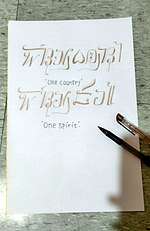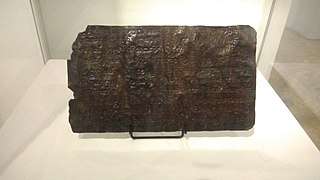Suyat
 |
| Calligraphy |
|---|

Suyat is the modern collective name of the indigenous scripts of various ethno-linguistic groups in the Philippines prior to Spanish colonization in the 16th century up to the independence era in the 21st century. The scripts are highly varied; nonetheless, the term was used by cultural organizations in the Philippines to denote a unified neutral terminology for Philippine indigenous scripts.[1][2]
Suyat includes the kulitan script of the Kapampangan people, the badlit script of various Visayan ethnic groups, the iniskaya script of the Eskaya people, the baybayin script of the Tagalog people, the buhid/buid script of the Buhid Mangyan people, the hanunó'o/hanunoo script of the Hanuno'o Mangyan people, the apurahuano/tagbanwa script of the Tagbanwa people, the palaw'an/pala'wan script of the Palaw'an people, the kur-itan script of the Ilokano people, and many other indigenous scripts in the Philippines.[3][4][5][6][1][2]
In 1999, four suyat scripts were inscribed in the UNESCO Memory of the World Programme, under the name Philippine Paleographs (Hanunoo, Buid, Tagbanua and Pala’wan). The four scripts, hanunó'o/hanunoo, buhid/buid, apurahuano/tagbanwa, and palaw'an/pala'wan, were recognized by UNESCO as the only existing suyat scripts still used by certain Philippine communities in their daily lives. UNESCO also recognized that the four scripts, along with thirteen other suyat scripts, have existed within the Philippine archipelago since the 10th century AD. The ambahan poetry made with the hanunó'o/hanunoo script was also cited. The inscription of the four suyat scripts was the first documentary heritage of the Philippines to be inscribed in the Memory of the World Programme.[7]
The diversity of suyat scripts have also established various calligraphy techniques and styles in the Philippines. Each suyat script has its own suyat calligraphy, although all suyat calligraphy are collectively called as Filipino suyat calligraphy for the sake of nationalism. Western-alphabet and Arabic calligraphy, however, are not considered as Filipino suyat calligraphy as the alphabets used did not develop indigenously. The variety of suyat scripts is due to four main factors: the alignment of the archipelagic culture with the Indosphere; the alignment of the archipelagic culture with the Sinosphere; the alignment of the archipelagic culture with both Indosphere and Sinosphere; and non-alignment of archipelagic culture to both Indosphere and Sinosphere.[8][9][1][2]
National writing system

The "National Script Act" has been in Congress since 2011. The bill aims to revive the usage of all known indigenous scripts in the Philippines. The bill also mandates that each community should teach the script respective to the area's ethnic peoples. The bill does not mandate the government to teach a single specific suyat script for all citizens, as that would demean the other suyat scripts of various ethnic peoples.[10]
Due to lack of congressional and senatorial sessions and support, the bill did not pass into law in the 16th Congress. It was refiled again in 2016 under the 17th Congress.
See also
References
- 1 2 3 Orejas, Tonette. "Protect all PH writing systems, heritage advocates urge Congress".
- 1 2 3 "The Baybayin bill and the never ending search for 'Filipino-ness'".
- ↑ "'Educate first': Filipinos react to Baybayin as national writing system".
- ↑ "House panel approves Baybayin as national writing system". 24 April 2018.
- ↑ News, ABS-CBN. "5 things to know about PH's pre-Hispanic writing system".
- ↑ "A primer on Baybayin".
- ↑ "Philippine Paleographs (Hanunoo, Buid, Tagbanua and Pala'wan) - United Nations Educational, Scientific and Cultural Organization". www.unesco.org.
- ↑ https://www.youtube.com/watch?v=9rrxOs-33aM
- ↑ "A primer on Baybayin".
- ↑ http://ical13.ling.sinica.edu.tw/Full_papers_and_ppts/July_21/P4-1.pdf